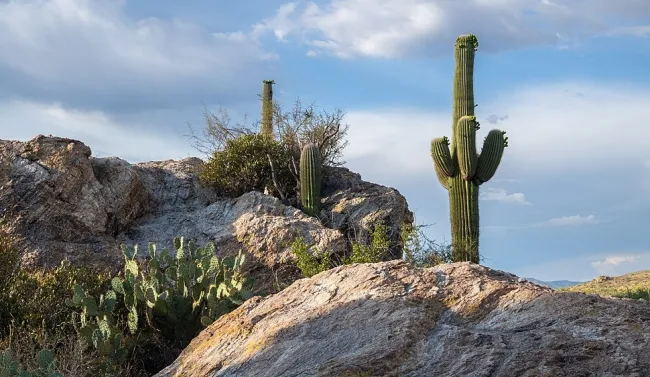
Saguaro National Park, located in southern Arizona, is named after the iconic saguaro cactus, a symbol of the American West. This unique park is divided into two districts—Saguaro East (Rincon Mountain District) and Saguaro West (Tucson Mountain District)—both offering an extraordinary experience of the Sonoran Desert. With towering cacti, diverse wildlife, and stunning sunsets, Saguaro National Park is a haven for nature lovers and outdoor enthusiasts.
History of the Park
Saguaro National Park was initially established as a national monument in 1933 to protect the saguaro cactus and other native flora and fauna. The park's significance grew, and in 1994, it gained full national park status. The park protects over 90,000 acres of desert landscape, preserving not only the saguaro cactus but also a variety of desert plants and animals that have adapted to this harsh environment over thousands of years.
Main Features
The star attraction of Saguaro National Park is the saguaro cactus, which can grow up to 60 feet tall and live for over 200 years. These giants of the desert are most impressive at sunrise and sunset when the light casts long shadows across the desert floor. In addition to saguaros, the park is home to a variety of other desert plants, including cholla, prickly pear cacti, mesquite trees, and palo verde trees. Wildlife such as roadrunners, javelinas, Gila monsters, and various birds also thrive in the park.
Types of Trails
Saguaro National Park offers over 165 miles of hiking trails that cater to all experience levels:
- Easy Trails: For a leisurely experience, the Desert Discovery Trail in the Tucson Mountain District is a paved, accessible trail that showcases the desert landscape.
- Moderate Trails: The Freeman Homestead Trail offers moderate difficulty with stunning views of the Rincon Mountains and educational signage along the way.
- Challenging Trails: For those seeking a challenge, the Tanque Verde Ridge Trail offers a strenuous climb with rewarding panoramic views of the desert and Tucson cityscape.
Crowd Expectations and Number of Annual Visitors
Saguaro National Park welcomes over 1 million visitors annually. While both districts can get busy during peak seasons (especially in winter and early spring), the park’s vastness allows for peaceful exploration, particularly on the less-traveled trails. The west district tends to be more popular due to its proximity to Tucson, but the east district offers a more remote and serene experience.
Accessibility for Seniors
Saguaro National Park is quite senior-friendly, offering several amenities and trails suitable for older visitors. The visitor centers in both districts provide helpful information, and many trails, such as the Desert Discovery Trail, are short and accessible, offering a comfortable way to explore the desert landscape.
Accessibility for Wheelchairs
The park provides wheelchair-accessible trails, including the Desert Discovery Trail and the Cactus Garden Trail, which are paved and offer a close-up experience of the desert ecosystem. Restrooms at both visitor centers are also wheelchair accessible.
Park Amenities
Saguaro National Park offers several amenities to enhance visitors' experiences:
- Visitor Centers: Both districts have visitor centers with educational exhibits, gift shops, and knowledgeable rangers available to answer questions.
- Picnic Areas: Designated picnic spots are available throughout the park, offering a place to rest and enjoy a meal amid the scenic desert surroundings.
- Guided Programs: The park offers ranger-led programs, including guided hikes, stargazing events, and talks on desert ecology.
Camping Facilities
Saguaro National Park does not have developed campgrounds, but backcountry camping is permitted in the Rincon Mountain District. Permits are required, and campers must be prepared for desert conditions, including carrying ample water and navigating rugged terrain.
Access to Lodging
While there are no lodging facilities within the park, the nearby city of Tucson offers a wide range of accommodations, from luxury resorts to budget-friendly hotels. The proximity to the park makes Tucson an ideal base for exploring both districts of Saguaro National Park.
Pet-Friendliness
Pets are allowed in Saguaro National Park but are restricted to certain areas. Pets must be kept on a leash at all times and are only allowed on paved roads and designated picnic areas. They are not permitted on trails, in buildings, or in the backcountry to protect the park's wildlife and sensitive desert environment.
Best Months to Visit
The best time to visit Saguaro National Park is from late fall to early spring (October to April), when temperatures are cooler and more comfortable for hiking and outdoor activities. The winter months offer pleasant daytime temperatures, while the spring brings wildflower blooms that add vibrant colors to the desert landscape. Summers in the park can be extremely hot, with temperatures regularly exceeding 100°F (38°C), so it's advisable to visit during the cooler months.
Conclusion
Saguaro National Park is a captivating destination that showcases the beauty and resilience of the Sonoran Desert. From the towering saguaro cacti to the diverse wildlife and stunning desert vistas, the park offers a unique experience for visitors of all ages. Whether you're hiking one of the many trails, enjoying a desert sunset, or learning about the ecosystem at the visitor center, Saguaro National Park is a place where the natural world takes center stage.



